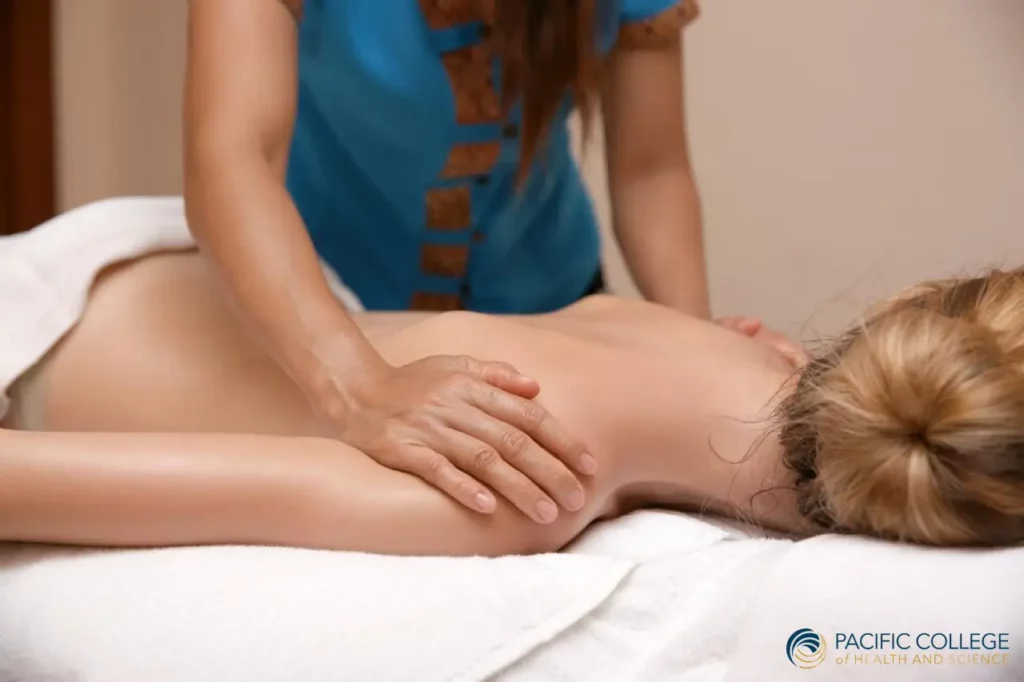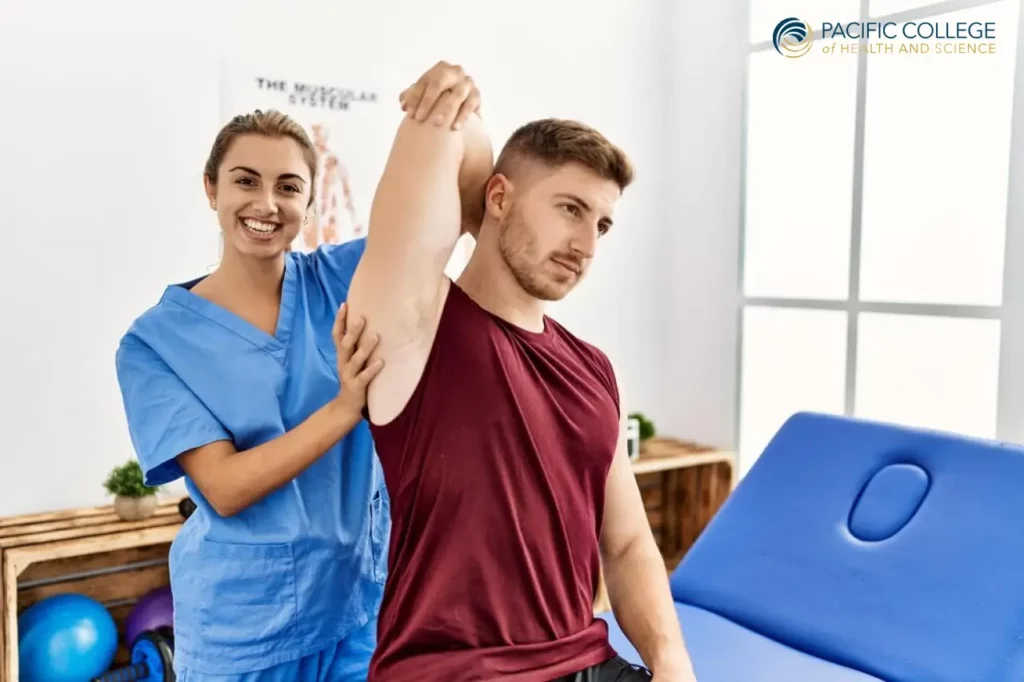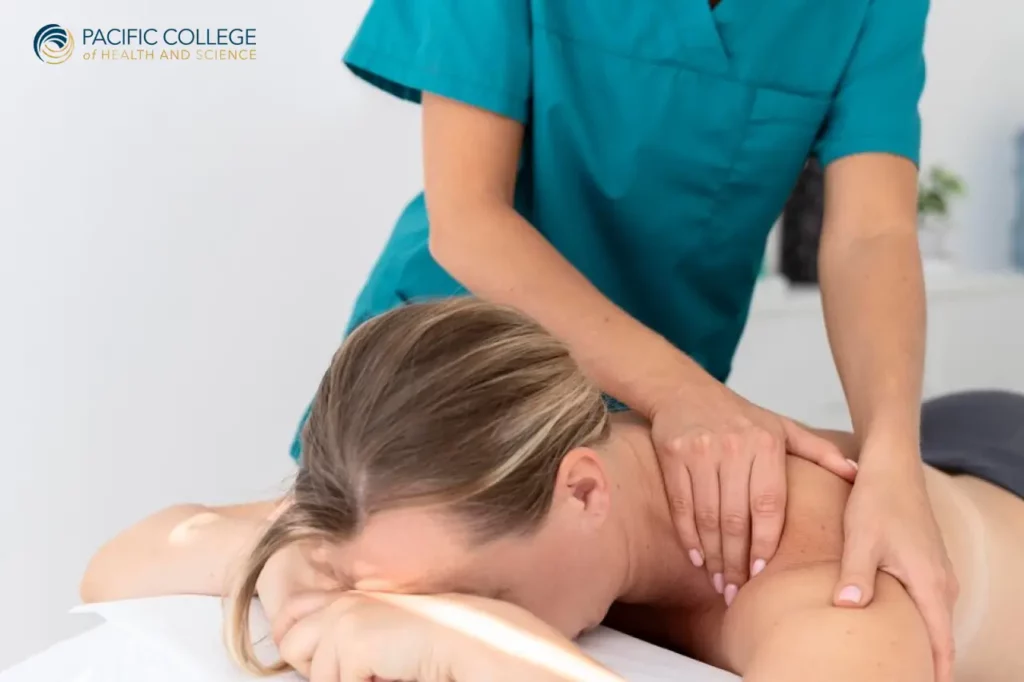Studying to become a massage therapist can grant you a fulfilling career focused on the health and well-being of your patients. Whether you’re passionate about holistic healing or simply want to help others feel their best, pursuing this career involves formal education, hands-on training, and certification. In this guide, we’ll walk you through the steps to becoming a licensed massage therapist.
What does a massage therapist do?
Massage practitioners help clients relax, ease tension, and address physical discomfort through a variety of techniques, with a focus on improving overall health. Key tasks performed include:
- Creating a therapeutic environment. Ensure the space is calm, clean, and relaxing for the client.
- Assessing client needs. Determine if the client is looking for stress relief, injury recovery, or specific health improvements.
- Developing personalized treatment plans. Customize the massage techniques to fit each client’s health needs.
- Selecting specialized techniques. Use specific massage methods like Swedish, deep tissue, or sports massage to target problem areas.
- Monitoring progress. Regularly assess the client’s improvement and adjust the treatment as necessary.
- Educating clients. Provide exercises or techniques clients can use at home to maintain results.
In combination, these practices help each client experience physical and mental relief while addressing their individual health needs.
How to become a massage therapist
Becoming a licensed massage practitioner involves completing an accredited massage therapy program, gaining hands-on experience, and passing licensing exams. The path can vary by state, but a solid foundation in anatomy, physiology, and different massage techniques are needed.
Complete a massage therapy program
To become a licensed massage therapist, the first step is to complete a massage therapy program from a reputable institution. These massage therapist programs offer coursework and hands-on training in areas like anatomy, physiology, and massage techniques. Students will also learn about safety practices, client management, and other important healthcare-related topics. Massage therapist college programs often include both theoretical instruction and practical application to prepare students for real-world client interactions.
The length of these programs varies by state and institution depending on state massage therapist education requirements, but typically range from six months to over a year. These programs are designed to prepare you for certification and licensure exams.
Complete practical requirements
To complete the practical requirements for becoming a massage therapist, students also need to engage in real-world experience. Most massage therapist training programs include a set number of mandatory practical hours, usually from 500 to 1,000 hours. These hours are very important for gaining the necessary massage therapist skills under the guidance of a licensed practitioner.
Many massage therapist programs offer internships or clinic-based practice, allowing students to treat clients, develop therapy plans, and monitor patient progress. This hands-on training is very important for understanding the therapeutic process in real-life settings. It also prepares students to meet the licensure and certification standards set by states.
Pass the state licensing exam
To become a licensed massage therapist, once you have finished your education and training, passing a state licensing exam is usually required. Most states require the Massage and Bodywork Licensing Exam (MBLEx), which consists of multiple-choice questions testing your knowledge in areas like anatomy, physiology, ethics, and patient assessment. The exam typically lasts about two hours, and you must obtain a passing grade to obtain licensure; if you fail the MBLEx, most states allow retakes after a 30-day waiting period. In some states, you might also need to take additional exams, such as the Board Certification in Therapeutic Massage and Bodywork (BCTMB). Prepare by reviewing all topics covered in your massage therapist courses and making sure your state’s licensing requirements align with the exams and certifications you chose.
Earn your massage therapy license
Earning your massage therapy license is the next important step. Licensing requirements vary by state, but most require proof of completion of an accredited massage therapist course and a passing score on the MBLEx or an equivalent exam. After meeting these criteria, you can apply for your license through the appropriate state board or regulatory agency. Once licensed, you can begin practicing as a professional massage therapist, whether in spas, wellness centers, or your own private practice.
Consider obtaining certification
Obtaining a massage therapy certification allows you to demonstrate expertise in specialized forms of massage, such as sports or therapeutic massage. This certification shows that you’ve undergone additional training beyond your basic massage therapist degree. Certification also shows that you are committed to professional development, which can help increase your earning potential and make you more appealing to employers and potential clients.
Certifications are offered through organizations like the National Certification Board for Therapeutic Massage and Bodywork (NCBTMB), which evaluates candidates on conditions, treatments, and ethical practices. By obtaining these specialized qualifications, you can expand your knowledge and skills in specific areas, such as treating certain conditions or working with types of clients.
Maintain your massage therapist license
To maintain your license, ongoing education and renewal are usually required. For example, many states mandate that a certified massage therapist undergo regular continuing education to keep their license active. Organizations like the NCBTMB (National Certification Board for Therapeutic Massage & Bodywork) require certified massage therapists to complete at least 100 hours of clinical experience and 24 hours of continuing education every few years. Additional massage therapist qualifications may include maintaining liability insurance to cover any potential legal issues related to patient care.
Are you interested in becoming a certified massage therapist?
Visit the links below to explore our massage therapy programs at a campus near you:
Benefits of becoming a massage therapist
A massage therapist’s career offers lots of benefits:
- Flexible Schedule. Many massage therapists have the opportunity to set their own hours, whether working independently or in spas, clinics, or wellness centers. This flexibility allows for a better work-life balance.
- Helping Others. Becoming a massage therapist means directly improving clients’ health by easing stress, pain, and tension. This sense of purpose can be deeply rewarding.
- Varied Work Environments. Massage therapists work in many settings such as health spas and hospitals. Some also establish private practices, offering opportunities for career growth.
- High Demand. As wellness and holistic health continue to grow in popularity, the demand for skilled massage therapists increases, making it a stable and promising career choice.
By pursuing a massage therapist’s career, you can enjoy both personal fulfillment and professional success.
How long does it take to become a massage therapist?
Becoming a massage therapist typically takes anywhere from a few months to two years, depending on the training program and state regulations. Most states require licensed massage therapists to complete an accredited massage therapy program and pass a recognized licensing exam. Programs can range from 300 to 1,000 hours of in-class and practical instruction, including hands-on clinical experience.
The duration of the program may depend on factors like the type of massage techniques taught and how extensive the clinical experience is. Longer programs that cover more techniques, including advanced modalities, better prepare therapists to meet the needs of their clients.
Career opportunities for massage therapists
Massage therapists have various career opportunities that offer variety and room for growth:
- Employment Options: Spas, Clinics, and Private Practice. Massage therapists can work in spas, wellness centers, hospitals, chiropractic offices, and even sports facilities.
- Building a Private Massage Therapy Practice. Many massage therapists choose to open their own practice, offering flexibility and autonomy in work schedules.
- Marketing Yourself as a Certified Massage Therapist. Developing marketing skills, networking, and building a client base are crucial to growing a successful private practice.
- Continuing Education and Advanced Massage Therapist Courses. Advancing your skills via additional certifications like sports massage or deep tissue therapy opens up specialized career ways and may also boost earning potential.
Important skills for becoming a massage therapist
To become a successful professional massage therapist, there are key skills required:
- Communication Skills. Listening closely to clients helps in understanding their needs and recommending the best course of treatment. Effective communication ensures clients feel heard and comfortable.
- Decision-Making Skills. A massage therapist must evaluate a client’s needs, choose appropriate techniques, and adjust treatments to address specific concerns, which require good judgment skills.
- Empathy. Understanding a client’s pain or discomfort is important for personalizing treatment plans that genuinely support your clients.
- Physical Strength and Stamina. Massage therapy can be very physically demanding. Therapists need to maintain their stamina, apply the correct pressure during sessions, and comfortably perform treatments over long periods of time.
The importance of choosing the right massage therapy school
Choosing the right massage therapy school is very important for building a solid foundation in your career. The quality of your education will directly impact your skills, knowledge, and confidence in providing treatments. A good massage school should offer a comprehensive curriculum that includes anatomy, physiology, a variety of massage techniques, and hands-on training through clinical practica that will prepare you for real-world situations.
Institutions like Pacific College of Health and Science stand out because of our strong reputation, offering well-rounded programs that meet the massage therapist education requirements. Attending a well-accredited massage therapy school can help you meet state licensing requirements and thrive in a competitive job market.
Conclusion
Becoming a massage therapist is a fulfilling educational path that ultimately offers a myriad of opportunities for professional growth and personal satisfaction. From selecting the right massage therapy school to gaining hands-on experience and obtaining certification, each step is important in creating a successful career. With the right training, you can build a rewarding career that allows you to help others while achieving personal and professional goals.
How to Become an Acupuncturist – FAQs
What is a massage therapist?
A massage therapist is a trained professional who uses touch and manual techniques to manipulate soft tissues of the body to ease pain, reduce stress, and help with relaxation and overall health. They often work in settings such as spas, clinics, and private practices.
How long is massage school?
Massage therapy school programs typically take six months to two years, depending on the program and state requirements. Programs generally require 300 to 1,000 hours of hands-on training and classroom instruction.
How much does it cost to become a massage therapist?
The cost of becoming a massage therapist varies depending on the school and program you choose. On average, tuition ranges from $3,000 to $15,000. Additional expenses may include liability insurance and purchasing supplies such as textbooks and massage tables. Public schools and community colleges generally offer more affordable options than private institutions. For those concerned about cost, financial aid, scholarships, and grants are available from various sources to help cover tuition and other related expenses.
How much does a massage therapist make?
A massage therapist in the United States typically earns between $47,000 and $58,000 annually, depending on factors like location, experience, and place of employment. Salaries may vary, with higher wages found in cities such as San Francisco or Washington DC. The average wage for a massage therapist across the U.S. is around $55,000 per year. Those working in spas, clinics, or their own practices may expect income variations depending on their clientele and business operations.
Featured Posts:





